|
|
|
|
 |
Luca Signorelli
|
|
Crtona 1441-1523
.Italian painter of the Umbrian school, who probably studied with Piero della Francesca. He worked in Cortona, where some of his paintings have remained. Subsequently he worked in the Cathedral of Perugia, in Volterra, and at Monte Oliveto before undertaking (1499) the decoration of the Cappella Nuova in the Orvieto Cathedral. There he represented the apocalyptic series of the Story of the Anti-Christ, the End of the World, the Resurrection of the Bodies, Paradise, and the Inferno, as well as figurations from antique poems and the Divine Comedy. The infernal scenes are remarkable for their imaginative evocation of fiends and tortures of Hell. Michelangelo was influenced by his powerful treatment of anatomy and the vivid realism he used for dramatic ends. Signorelli's paintings in the Vatican, where he went in 1508, were later sacrificed to make way for some of Raphael's work. |
|
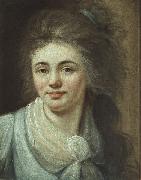 |
Ludovike Simanowiz
|
|
Deutsch: Friedrich Schiller (1759 - 1805), Ölgemälde von Ludovike Simanowiz 1793/94
English: Friedrich Schiller, German poet, philosopher, historian, and dramatist |
|
|
|
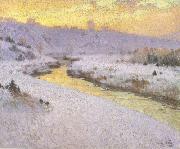 |
marc-aurele de foy suzor-cote
|
|
Canadian Painter, 1869-1937
was a Canadian painter and sculptor. He was born in Arthabaska, Quebec in 1869. He studied at the École des Beaux-Arts in Paris with L??on Bonnat during the 1890s. After his return to Quebec in 1908, he produced many impressionist paintings of the Quebec landscape, as well as portraits, nudes, historical paintings and later sculptures. |
|
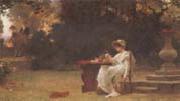 |
Marcus Stone
|
|
British
1840-1921
English painter, son of Frank Stone, ARA, was trained by his father and began to exhibit at the Academy before he was eighteen; and a few years later he illustrated with much success books by Charles Dickens, Anthony Trollope, and other writers, friends of his family. He was elected an associate of the Royal Academy in 1877, and academician in 1887. In his earlier pictures he dealt much with historical incidents, but in his later work he occupied himself chiefly with a particular type of dainty sentiment, treated with much charm, refinement and executive skill. |
|
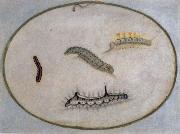 |
Maria Sibylla Merian
|
|
German Baroque Era Illustrator, 1647-1717,Daughter of Mattheus Merian. After her father's death, her mother married in 1651 the flower still-life painter Jacob Marell, who became Maria Sibylla's teacher. On 16 May 1665 she married Johann Andreas Graff, another pupil of her stepfather. She thenceforth specialized in illustrations of flowers, fruit and, especially, grubs, flies, gnats and spiders. In 1670 the family moved to Nuremberg. In 1675 Sandrart referred to her in the Teutsche Academie, reporting that she painted on cloth (i.e. silk, satin). With Graff, she produced a book of flowers, the first part appearing in 1675; a second edition, enlarged by parts 2 and 3 ,came out in 1680, entitled Florum fasciculi tres. It included 36 engravings intended to serve as patterns for embroidery. |
|
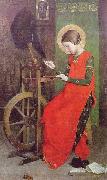 |
Marianne Stokes
|
|
(1855 Graz, Styria - August 1927 London), born Marianne Preindlsberger in the Austrian province of Styria, was an Austrian painter. She settled in England after her marriage to Adrian Scott Stokes (1854-1935), the landscape painter, whom she had met in Pont-Aven. Marianne Stokes was considered one of the leading artists in Victorian England.
Preindlsberger first studied in Munich under Lindenschmidt and having been awarded a scholarship for her first picture, 'Muttergluck', she worked in France under Pascal Adolphe Jean Dagnan-Bouveret (1852-1929), Colin and Gustave Courtois (1853-1923). She painted in the countryside and Paris, and, as with many other young painters, fell under the spell of the rustic naturalist Jules Bastien-Lepage. Her style continued to show his influence even when her subject matter changed from rustic to medieval romantic and biblical. While in France she met the Finnish painter Helene Schjerfbeck, in whose company she visited Pont-Aven in 1883.
Her first salon painting, 'Reflection', which had been painted in Brittany, was exhibited in 1885 at the Royal Academy. Her work was also shown at the Grosvenor Gallery, New Gallery, and the Society of British Artists and in 1885, a year after her marriage, she took to using the name 'Mrs. Adrian Stokes'. She held a joint exhibition with her husband at the Fine Art Society in 1900. The Stokes' lived in St Ives where Marianne was a member of the Newlyn School. Having no children, they regularly travelled abroad, frequently to the Tyrol, and in 1905 to Slovakia and the High Tatra. Here they spent about half a year sketching and painting in the villages of Važec, Mengusovce and Ždiar. Adrian Stokes concentrated on landscapes with images of hay-harvesting and picturesque cottages, while Marianne Stokes painted portraits showing fine detail of the garments. These paintings provide a valuable record of the Slovak culture.
After abandoning oils, and inspired by the Pre-Raphaelite movement, she painted flat compositions in tempera and gesso, her paintings giving the impression of being frescoes on plaster surfaces. She was an Associate of the Royal Society of Painters in Water Colours.
|
|
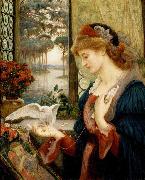 |
Marie Spartali Stillman
|
|
English Pre-Raphaelite Painter, 1844-1927
was a British Pre-Raphaelite painter of Greek descent, arguably the greatest female artist of that movement. During a sixty-year career she produced over one hundred works, contributing regularly to galleries in Great Britain and the United States. Maria Spartali was the youngest daughter of Michael Spartali, a wealthy merchant and Greek consul-general based in London, and his wife Euphrosyne. She and her cousins Maria Zambaco and Aglaia Coronio were known collectively among friends as "the Three Graces", after the Charites of Greek mythology (Aglaia, Euphrosyne and Thalia), as all three were noted beauties of Greek heritage. Swinburne said of Spartali: "She is so beautiful that I want to sit down and cry". Spartali studied under Ford Madox Brown for several years from 1864, with his children Lucy, Catherine and Oliver. She modelled for: Brown; Burne-Jones (The Mill); Julia Margaret Cameron; Rossetti (A Vision of Fiammetta, Dante's Dream, The Bower Meadow); Spencer Stanhope; and Whistler (La Princesse du Pays de la Porcelaine). In 1871, against her parents' wishes, she married American journalist and painter William J. Stillman. She was his second wife, his first having committed suicide two years before. His job as a foreign correspondent resulted in the couple dividing their time between London and Florence from 1878 to 1883, and then Rome from 1889 to 1896. |
|
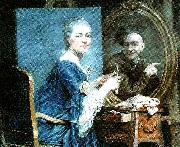 |
marie suzanne giroust roslin
|
|
Marie-Suzanne Giroust, född 9 mars 1734 i Paris, Frankrike, död 31 augusti 1772 i Paris, var en fransk konstnär, i huvudsak verksam inom pastellmåleri. Hon var gift med den svenske porträttmålaren Alexander Roslin från 1759 till sin död.
Dotter till Barthelemy Giroust och Marie Suzanne Leroy. När Giroust var sju år gammal, dog hennes far som var juvelerare. Fyra år senare dog även hennes mor, och hon flyttade in hos släktingar. Arvet efter fadern gav henne möjlighet att uppta målarstudier. Hon inledde sina studier hos Maurice Quentin de La Tour, men det var hos Joseph-Marie Vien hon kom att finna sig tillrätta. I Viens atelj?? träffade hon 1752 Alexander Roslin och blev förälskad. Girousts förmyndare kunde dock inte acceptera den svenske målaren som blivande make, då han var fattig och protestant.[1] Paret kämpade för sin kärlek, och Giroust vägrade att träffa de friare som hennes förmyndare föreslog för henne.[1] Efter medling av bland andra Roslins vän och beskyddare, Comte de Caylus, kunde Roslin och Giroust gifta sig, den 5 januari 1759. Paret Roslin fick mellan 1760 och 1772 sex barn, tre döttrar och tre söner, varav två döttrar och två söner nådde vuxen ålder.
Alexander Roslin erkände offentligen sin hustrus talang som konstnär, och han hävdade att hon var en skickligare pastellmålare än han själv. Giroust invaldes 1770 i den franska konstakademin, Acad??mie royale. 1771 utställde hon sitt porträtt av abb?? Lemonnier, som fick mycket beröm. Hon måladet i pastell.
Marie-Suzanne Giroust avled i bröstcancer i slutet av augusti 1772. |
|
 |
Marmion, Simon
|
|
French-born Flemish Northern Renaissance Painter, ca.1425-1489
French illuminator and painter. He was trained in Amiens and established a productive workshop in Valenciennes, but at the end of his career appears to have had connections with manuscript painting in the southern Netherlands. Although no signed or documented works survive, many illuminated manuscripts and some panel paintings have been convincingly attributed to him and his workshop. On the basis of these he has been recognized as an important figure in the development of both French and Netherlandish painting. |
|
 |
Martin Archer Shee
|
|
RA (December 23, 1769 - August 13, 1850) was a British portrait painter and president of the Royal Academy.
He was born in Dublin, of an old Catholic Irish family, and his father, a merchant, regarded the profession of a painter as an unsuitable occupation for a descendant of the Shees. Martin Shee nevertheless studied art in the Dublin Society, and came to London. There, in 1788, he was introduced by William Burke to Joshua Reynolds, on whose advice he studied in the schools of the Royal Academy. In 1789 he exhibited his first two pictures, the "Head of an Old Man" and "Portrait of a Gentleman." Over the next ten years he steadily increased in practice. He was chosen an associate of the Royal Academy in 1798, in 1789 he married, and in 1800 he was elected a Royal Academician. He moved to George Romney's former house in Cavendish Square, and set up as his successor.
Shee continued to paint with great readiness of hand and fertility of invention, although his portraits were eclipsed by more than one of his contemporaries, and especially by Thomas Lawrence. The earlier portraits of the artist are carefully finished, easy in action, with good drawing and excellent discrimination of character. They show an undue tendency to redness in the flesh painting defect which is still more apparent in his later works, in which the handling is less "square," crisp and forcible. In addition to his portraits he executed various subjects and historical works, such as Lavinia, Belisarius, his diploma picture "Prospero and Miranda", and the "Daughter of Jephthah."
In 1805 he published a poem consisting of Rhymes on Art, and a second part followed in 1809. Lord Byron spoke well of it in his English Bards and Scotch Reviewers. Shee published another small volume of verse in 1814, entitled The Commemoration of Sir Joshua Reynolds, and other Poems, but this was less successful. He also produced a tragedy, Alasco, set in Poland. The play was accepted at Covent Garden, but was refused a licence, on the grounds that it contained treasonable allusions, and Shee angrily resolved to make his appeal to the public. He carried out his threat in 1824, but Alasco was still on the list of unacted dramas in 1911. He also published two novels - "Oldcourt" (1829, in 3 volumes) and "Cecil Hyde" (1834). |
|
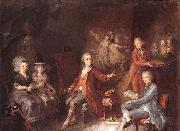 |
Martin Johann Schmidt
|
|
Austrian Painter, 1718-1801,was one of the most outstanding Austrian painters of the late Baroque/Rococo along with Franz Anton Maulbertsch. A son of the sculptor Johannes Schmidt and a pupil of Gottlieb Starmayr, he spent most of his life at Stein, where he mostly worked in the numerous churches and monasteries of his Lower Austrian homeland. While the evolution of his style after 1750 shows that he had either spent a formative period in northern Italy or had at least had extensive contact with northern Italian works of art prior to that date, his works are also clearly influenced by Rembrandt (visible above all in his etchings) and the great fresco-painters of the Austrian Baroque, Paul Troger and Daniel Gran. Despite not having received formal academic training, in 1768 he was made a member of the imperial academy at Vienna due to his artistic merits, which by that time had already been recognized by a wider public inside and outside of Austria. Primarily he painted devotional images for private devotion and churches, including a considerable number of large altar paintings. His lively and colourful style made him extremely popular with people from all levels of society already during his lifetime. From 1780 mythological and low-life themes became increasingly frequent, only to be replaced by a renewed concentration on religious topics during the very last years of Schmidt's life. He was at that an important draughtsman and has left numerous etchings which clearly show Rembrandt's influence. While his earlier works typically show a warm chiaroscuro, from about 1770 he used increasingly stronger and more lively colours. Simultanueously, both his style and his brush technique became much more free, making him, like Franz Anton Maulbertsch, an important predecessor of impressionism. In this aspect, his mature style is completely contrary to neoclassicism, the style which increasingly dominated European art after about 1780. |
|
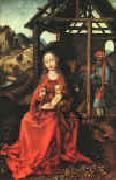 |
Martin Schongauer
|
|
1430-1491
German
Martin Schongauer Galleries
His father was a goldsmith named Casper, a native of Augsburg, who had settled at Colmar, where the chief part of Martin's life was spent. He may well have been trained by Master E. S.; A. Hyatt Mayor saw both their styles in different parts of one engraving, and all the works with Schongauer's M†S monogram show a fully developed style. Schongauer established at Colmar a very important school of engraving, out of which grew the "Little Masters" of the succeeding generation, and a large group of Nuremberg artists.
As a painter, Schongauer was a follower of the Flemish Rogier van der Weyden, and his rare existing pictures closely resemble, both in splendour of color and exquisite minuteness of execution, the best works of contemporary art in Flanders.
Porträt einer jungen Frau, by Martin Schongauer, c. 1478, located in Sammlung Heinz Kisters, Kreuzlingen (Schweiz) in GermanyAmong the very few paintings which can with certainty be attributed to him, the chief is a magnificent altar-piece in the church of Saint Martin at Colmar. The Mus??e d´Unterlinden in Colmar possesses eleven panels by him, and a small panel of David with Goliath's Head in the Munich Gallery is attributed to him. The miniature painting of the Death of the Virgin in the National Gallery, London is probably the work of some pupil. In 1488 Schongauer died at Colmar, according to the register of Saint Martin Church. Other authorities state that his death occurred in 1491.
The main work of Schongauer's life was the production of a large number of beautiful engravings, which were largely sold, not only in Germany, but also in Italy and even in England and Spain. Vasari says that Michelangelo copied one of his engravings, the Trial of Saint Anthony. His style shows no trace of Italian influence, but a very clear and organised Gothic.
His subjects are mainly religious, but include comic scenes of ordinary life such as the Peasant family going to market or the Two apprentices fighting. one hundred and sixteen engravings are generally recognised as by his hand, and since several are only known from a single impression, there were probably others that are now lost. Many of his pupils' plates as well as his own are signed, M†S, as are many copies probably by artists with no connection to him.
Crucifixion by Schongauer.Among the most renowned of Schongauer's engravings are the series of the Passion and the Death and Coronation of the Virgin, and the series of the Wise and Foolish Virgins. All are remarkable for their miniature-like treatment, their brilliant touch, and their chromatic force. Some, such as the Death of the Virgin and the Adoration of the Magi are richly-filled compositions of many figures, treated with much largeness of style in spite of their minute scale.
He established the system of depicting volume by means of cross-hatching (lines in two directions) which was further developed by D??rer, and was the first engraver to curve parallel lines, probably by rotating the plate against a steady burin. He also developed a burin technique producing deeper lines on the plate, which meant that more impressions could be taken before the plate became worn.
The British Museum and other major print rooms possess fine collections of Schongauer's prints. |
|
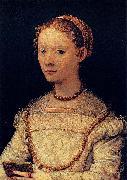 |
Maso da San Friano
|
|
(1536-1571) was an Italian painter active in Florence. His real name was Tomaso D'Antonio Manzuoli. He was born in San Friano and died in Florence.
According to Giorgio Vasari, Maso was a pupil of Pier Francesco Foschi while others claim it was Carlo Portelli. He collaborated with an elder Michelangelo on some projects.
His altarpiece of the Visitation was painted in 1560 for the church of San Pier Maggiore of Florence - now in Trinity Hall Chapel, Cambridge, England. A similar work can be seen in the Prato cathedral. After 1561, he painted in the church of Ognissanti, Florence and in the church of Santa Felicita. He participated in the decoration of the Studiolo of Francesco I with an oval canvas relating the Fall of Icarus story (1572). The canvas has an affected milling in individuals below and an anomalous perspective; both are classic features of mannerist painting. His second contribution Mining of Diamonds. A portrait of Ferdinando I de' Medici (1570) by Maso can be found in the Town Council Hall of Prato.
He is thought to be one of part of the Contra-Maniera or Counter-Mannerism movement in Florence. His most important pupils were Jacopo da Empoli and Alessandro Fei.
One of his paintings, thought to be of Cosimo I de Medici in 1560, is believed to be the oldest to show a watch
|
|
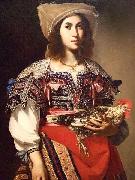 |
Massimo Stanzione
|
|
(also called Stanzioni; c. 1586 - c. 1656) was an Italian Baroque painter, mainly active in Naples.
Massimo Stanzione was an Italian Baroque painter. Born in Naples in 1586, Massimo was greatly influenced by Michelangelo Merisi da Caravaggio, but what earned him the nickname of The Neapolitan Guido Reni was his sophisticated and graceful style. The thing that distinguished Massimo art from Carravaggism was that he combined Caravaggio dramatically lit and brutally realistic style with the classical and lyrical manner of Bolognesi painters.
Though his preliminary training is uncertain, it is thought that he studied with Fabrizio Santafede; however, most of the influence he received was from Caravaggio. Art historians believe that Stanzione developed his career as an artist in Rome. It is thought that he bagan his career as a portraitist. Some of his most famous works include Portrait of a Woman in Popular Costume, and Portrait of Jerome Banks. Between 1617 and 1630, it is believed that he traveled between the papal city and his hometown of Naples exploring different styles of art. Also influenced by Caravaggio were Artemisia Gentileschi, Simon Vouet, and Carlo Saraceni. During Stanzione career a movement that changed the style of art was formed. Stanzione was a part of this movement. This movement transformed the dark, contrasted Caravaggio-styled art into Bolognese colorism and soft art.
|
|
|
|
 |
Master of Saint Giles
|
|
The Master of Saint Giles (French: Maître de Saint-Gilles) was a Franco-Flemish painter active, probably in Paris, about 1500, working in a delicate Late Gothic manner, with rendering of textures and light and faithful depictions of actual interiors that show his affinities with Netherlandish painting. It is not clear whether the Master of Saint Giles was a French painter who trained in the Low Countries (perhaps more likely), or a Netherlander who emigrated to France.
His pseudonym was given him by Max Friedländer, who reconstructed part of the anonymous painter's oeuvre, starting from two panels devoted to Saint Giles (a Miracle and a Mass) in the National Gallery, London, that were part of the lefthand shutter of an altarpiece, and two further panels now in Washington from the same altarpiece. The hand of an assistant can be discerned in the Baptism of Clovis at the National Gallery of Art, Washington, who also have a panel with Episodes from the Life of a Bishop-Saint - perhaps Saint Leu, Saint Denis or Saint Remy. All four panels have, or had, single grisaille figures of saints (Saints Peter, Giles, Denis and an unidentified bishop-saint) in niches, imitating sculpture, on the reverse. The Washington pair, which were in poor condition, have been separated and are lost, although photographs exist. Undoubtedly there were further panels, whose subjects cannot be guessed, as the combination of scenes is original. |
|
|
|
|
|
|
|
|
|
|
|
|
|
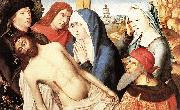 |
Master of the Legend of St. Lucy
|
|
(fl. 1480-1510) was an unidentified Early Netherlandish painter who worked in Bruges, now a city in Belgium. His name comes from for an altarpiece in the church of Saint James in Bruges, which is dated 1480 and depicts three scenes from the life of Saint Lucy. Since then, twenty-five to thirty-five paintings have been attributed to the same hand. He may have trained Spanish students at his studio in Bruges. Many of them are characterized by views of the city of Bruges in the background, and can be dated according to the level of construction of its belfry. He may have trained with Dieric Bouts, and was certainly influenced by Bruges' greatest artist at the time, Hans Memling.
|
|
|
|
|
|
|
|
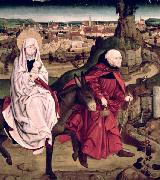 |
Master of the Schotten Altarpiece
|
|
was a German painter, active in Nuremberg during the 14th and 15th centuries. His name is derived from an altarpiece dated to about 1390, which once stood in the church of St. Mary in Schotten. The altarpiece was dismantled in 1828.
|
|
|
|
|
|
|
|
|
|
 |
Max Slevogt
|
|
German Impressionist Painter, 1868-1932
German painter, printmaker and illustrator. His father, adjutant and friend of the future Prince Regent, Luitpold (1821-1912), died when Slevogt was just two years old. His mother moved to Werzburg, where he spent his schooldays. Even in his childhood and adolescence, family connections brought Slevogt to Pfalz, to an aunt in Landau and to the Finkler family in Neukastel. Initially he had planned to become a musician, but he began to study painting at the Akademie der Bildenden Kenste in Munich in 1885. His fellow students included Gabriel von Hackl (1843-1926), Karl Raupp (1837-1918), Ludwig Herterich (1856-1932) and Wilhelm von Diez (1839-1907). In 1889 he spent a term at the Academie Julian in Paris. At that time Impressionism had very little effect on him. Following a trip to Italy in 1890 with the painter Robert Breyer (1866-1941) who had befriended him at the Akademie, he began to work independently as a painter in Munich. In 1893 he participated in the first exhibition of the newly founded Munich Secession, exhibiting Wrestling School (1893; Edenkoben, Schloss Villa Ludwigshehe); the judges wanted to refuse this painting as immoral since its entwined and naked men caused offence. In the following years his paintings often appeared harsh and non-academic to conservative Munich circles. At this time Slevogt also made contributions to the journals Jugend and Simplizissimus, which were significant in the development of his graphic work. |
|
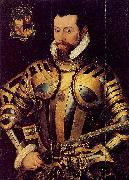 |
Meulen, Steven van der
|
|
Flemish Northern Renaissance Painter, active 1543-1568
Netherlandish painter active in England. He was a pupil of Willem van Cleve the younger (c. 1530-1564) in 1543 and was admitted to the Antwerp Guild of St Luke in 1552; by 1560 he had travelled to London, and he was naturalized in 1562. Van der Meulen brought with him a deep knowledge of the portrait style of Anthonis Mor. This sombre, shadowed style appealed to patrons at the English court who could not travel to Antwerp to sit to the greater artist. Early in 1561 an English merchant, John Dymoch, had visited Sweden in connection with negotiations for a marriage between Queen Elizabeth and Erik XIV, taking with him a Netherlandish painter described as 'Master Staffan', and it seems likely that this was van der Meulen. The King was much pleased with the resulting portrait of himself, for which he paid 100 daler |
|
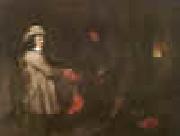 |
Michael Sweerts
|
|
Flemish
1618-1664
Michiel Sweerts (September 29, 1618 - 1664), also known as Michael Sweerts, was a Flemish painter of the Baroque period, active in Rome (1645-1656) in the style of the Bamboccianti. The Bamboccianti were known for depicting genre scenes of daily life.
Born in Brussels, he arrived in Rome in the mid 1640s, and rapidly moved into the circle of Flemish painters that had arrayed around Pieter van Laer, and that resided near Santa Maria del Popolo. In 1647, he attended meetings of the Accademia di San Luca, although not as a member. By 1659, he had returned to Brussels, where he joined the painter's guild.
He appears to have become mentally unstable in his last years. In Amsterdam, he joined the Jesuits as a "lay Brother" rather than a priest, and sailed from Marsaille to the East with a missionary group. Travelling to Jerusalem, and from there to Goa, where after causing tribulations to those around him, he died.
Sweerts is an enigmatic and difficult artist to categorize, since he seems to have absorbed a variety of influences to create an eclectic hybrid that can be described as a Netherlandish genre adaptation of an early tenebrist styles: a blend of Vermeer's genre of painting and Caravaggio-influenced full bodied figures.
|
|
 |
Michel Sittow
|
|
(c.1469-1525) was a painter from Reval (now Tallinn, Estonia) who was trained in the tradition of Early Netherlandish painting. For most of his life, Sittow worked as a court portrait painter, for Isabella of Castille, the Habsburgs and others in Spain and the Netherlands. He was one of the most important Flemish painters of the era.
|
|
|
|
 |
Michiel Sweerts
|
|
(29 September 1618-1664), also known as Michael Sweerts, was a Flemish painter of the Baroque period, active in Rome (1645-1656) in the style of the Bamboccianti. The Bamboccianti were known for depicting genre scenes of daily life, but Sweerts's contributions to this genre display greater stylistic mastery and social-philosophical sensitivity than many of his colleagues in this "school." Highly successful in Rome during his years there, Sweerts's reputation suffered a severe collapse not long after his death, lasting centuries; but thanks especially to the 2002 international monographic exhibition devoted entirely to him, Michael Sweerts: 1618-1664, he has begun once again to enjoy the esteem his work clearly merits.
Born in Brussels, he arrived in Rome in 1646, and rapidly moved into the circle of Flemish painters associated with Pieter van Laer (leader of the so-called Bamboccianti painters) and that resided near Santa Maria del Popolo. In 1647, he attended meetings of the Accademia di San Luca, although not as a member. Despite the fragmentary nature of evidence pertaining to his career in Rome and the post-mortem eclipse of his reputation, we know that Sweerts succeeded in creating for himself a sufficiently exalted reputation in the city so as to enter into the service of the ruling papal family itself, the Pamphilj, more specifically, Camillo Pamphilj, nephew of reigning Pope Innocent X who, at the encouragement of Camillo, bestowed upon Sweerts the papal title of Cavaliere di Cristo, the same honor enjoyed by the likes of Gian Lorenzo Bernini and Francesco Borromini. Despite working in the highest echelons of papal patronage in Rome, sometime between 1652 and 1654, for reasons unknown Sweerts left the Eternal City and returned to the North, and by 1656, he had returned to Brussels, where he joined the painter's guild. He joined the Paris Foreign Missions Society as a lay brother and became a devout Christian. In 1658 he made the guild a self portrait as a farewell gift and moved to Amsterdam, where he would oversee the building of a ship for travel with the aforementioned Missions Étrangeres to Palestine. |
|
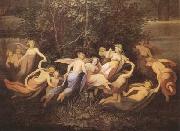 |
Moritz von Schwind
|
|
Austrian Romantic Painter, 1804-1871
Austrian painter and illustrator. He studied at the Akademie der Bildende K?nste in Vienna (1821-3), where he was influenced by the Biedermeier genre painter Peter Krafft and the Nazarene painter Ludwig Ferdinand Schnorr von Carolsfeld. He made copies after the Old Masters at the Belvedere in Vienna, exploring especially D?rer, Albrecht Altdorfer, Raphael and Titian, which completed his early, largely autodidactic experience of art. His friendship with Franz Schubert, the poet and playwright Franz Grillparzer and the painters Ferdinand and Friedrich Olivier, as well as the cultural environment of Biedermeier Vienna in his years there between 1823 and 1828, shaped his spiritual development as a painter. His love of music inspired his later 'symphonic' compositions and flowing linear rhythms. Extensive reading of the work of Romantic writers such as Achim von Arnim, Clemens von Brentano, Ludwig Tieck, Friedrich Heinrich von Hagen and the brothers Jacob and Wilhelm Grimm helped prepare his mature pictorial themes of fairytales, legends and sagas. He was unsuccessful as a painter and eked out a meagre livelihood by drawing naturalistic genre scenes for engravers, while occasionally selling a painting. Walk before the City Gate |
|
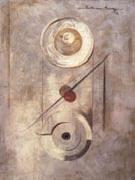 |
Morton Schamberg
|
|
American Painter and Architect ,
b.1881-d.1918
American painter and photographer. After training as an architect at the University of Pennsylvania, Philadelphia (A.B., 1903), he studied painting at the Pennsylvania Academy of the Fine Arts, also in Philadelphia, from 1903 to 1906 under William Merritt Chase, with whom he travelled to Europe. From 1907 to 1909 he lived mostly in Paris, where he saw the work of major avant-garde artists, including C?zanne, Picasso and Matisse, and benefited from contact with Leo Stein, an important collector and writer. By 1909 Schamberg had responded to the example of C?zanne's paintings, including simplified and more solid forms in his own work. Following his participation in the Armory Show in 1913, Cubism became the dominant element of his art, modified in such works as Figure B, Geometric Patterns |
|
|
|
 |
Myles Birket Foster,RWS
|
|
1825-1899
English painter, illustrator and collector. After a short and unsatisfactory period working in the family brewing business, he was able to convince his Quaker parents to allow him to pursue a career in art. He was apprenticed to a wood-engraver, Ebenezer Landells (1808-60), who recognized Foster's talent for drawing and set him to work designing blocks for engraving. Foster also provided designs for Punch and the Illustrated London News. In 1846 he set up on his own as an illustrator. The rustic vignettes of the seasons that he contributed to the Illustrated London News and its counterpart, the Illustrated London Almanack, established him as a charming interpreter of the English countryside and rural life and led to his employment illustrating similar themes in other publications. During the 1850s his designs were much in demand; he was called upon to illustrate volumes of the poetry of Longfellow, Sir Walter Scott and John Milton. |
|
|
|
|
|
|
|
|
|
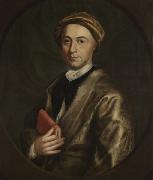 |
Nathaniel Smibert
|
|
(January 20, 1734 - November 8, 1756), was an artist in Boston, Massachusetts, in the mid-18th century. Born in Boston in 1734, he trained as a painter with his father, the artist John Smybert, and produced several portraits, notably of Ezra Stiles, architect Peter Harrison, and Dorothy Wendell (in the Collection of Dr John L Hale, Boston). |
|
|
|
|
|
|

